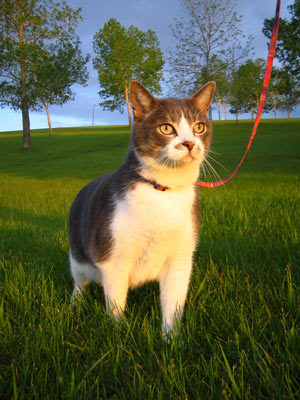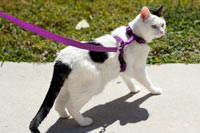How to Train Your Cat to Walk on a Leash

Walking your cat outside has the potential to provide many good times for both your kitty and you, but it is a serious endeavor that can be fraught with mishaps and outright danger if it is done haphazardly. It is also not right for every cat.
Why Walk Your Cat?
Leash-walking, when the proper precautions are taken, can allow your kitty to expand her horizons and get in touch with some of her wildness in a way that's safe for both her and the local wildlife. On a leash, your kitty can leave her scent on branches, scratch her claws on tree trunks, and pick a random spot in the grass on which to repose. A leash walk can give your cat new opportunities for discovery, and it also relieves stress and boredom. Leash-walking can be great fun, but it is not suitable for all cats.
If your cat has no interest in the outdoors, that's fine; don't force her. Make your house the best cat-home ever, and strive to make your kitty's indoor life rewarding, safe, and happy.
Leash-Walking Is Much Safer than Letting Your Cat Roam Outdoors Alone
Please consider leash-walking as an alternative to letting your cat outside alone. An outdoor cat is exposed to a multitude of risks, including ingesting toxic substances, getting into brawls with other cats, being attacked by wild animals or unleashed dogs, or being hit by a car. Cats that go outside have a shorter life expectancy than those that stay inside or are outside on a strictly supervised basis.
When to Think Twice About Leash-Walking Your Cat
There are some circumstances in which it's not a good idea to attempt leash-training with your cat. Some of these include that:
- Your cat is skittish. There may be dump trucks, leaf blowers, construction, kids yelling, dogs barking, and other loud or sudden noises outside. If your cat is particularly nervous or high-strung, leash-walking is probably not a good idea for her.
- You live in a busy downtown area. Even if your kitty is fairly calm, a noisy, bustling city can frazzle her nerves. It's best to keep her inside if you live in such an area.
How to Know If Your Cat Might Be Ready for Walks
Your cat should be secure in her home environment and know that it is where she should return if she is ever lost. Before you consider walking your cat, the following should be true:
- Your cat has lived in your present home for at least two months.
- She has a close relationship with the inhabitants, especially you.
- She has favorite places in the house.
- She seems rather settled in and has a comfortable, stable routine.
- She knows where things are.
- She leaves her scent around the house through daily scratching and rubbing on things.
- Her urge to hunt is satisfied through frequent play sessions with you.
- Your kitty is spayed or neutered.
- Things about the house or who lives there haven't substantially changed in the last four to eight weeks. For instance, you haven't recently added a baby or a dog to the family, remodeled, or experienced a change in the schedule or the departure of your kitty's favorite feline or human companion.
Preparing for Walking Your Cat on a Leash
If you've decided that leash-walking is a good idea for your cat and the above prerequisites have been met, be sure that you don't just throw a collar and leash on your feline friend and run out the door. There is considerable prep work to be done before you're ready for that. Below are some things to take care of before starting leash-training.
- Teach your cat to come when you call her. Before starting to leash-train, it's important that you've taught your cat to come when you call her. That way, if she does get loose while you are outside, you are more likely to be able to get her to come back to you promptly. Learn more in this article: "Clicker Training for Cats: Come When Called."
- Train your cat to be picked up and carried. For leash-walks, you will always carry your kitty out the door, with her harness on and with the leash's end firmly in your hand. This is also usually how you will re-enter the house after the walk. So it is essential that your cat is amenable to you picking her up and holding her in your arms. It is also important that you be able to pick your cat up and carry her in case a dangerous situation arises while you are walking her.
- Consider having your cat microchipped. The microchipping procedure is painless and inexpensive, has no side effects, and takes two seconds. A microchip provides permanent identification for your cat. Most shelters, veterinarians, and an increasing number of animal control officers are equipped with wands that can detect the chips. A microchip has a unique ID code that identifies your cat in the chip manufacturer's database. Many lost cats have been reunited with their families thanks to this technology. Visit "Microchipping Your Cat" to learn more.
- Also have visible identification for your cat. In addition to a microchip, it's important to have an ID tag that displays your current contact information attached to your cat's harness at all times when you are outside.
- Use flea and tick preventative on your cat. Consult with your veterinarian to determine the best product for your cat and your area. Never use over-the-counter flea and tick preventatives; some of them are extremely toxic to cats. You can learn more in this article: "Flea Control for Cats."
- Make sure your cat is up-to-date on her vaccinations and heartworm preventative. Your veterinarian is best-suited to help you decide which vaccinations and what type of heartworm preventative are best for your cat, as well as how often both are needed. Be sure and tell the doctor that you are planning to leash-walk your cat when discussing these issues.
- Don't use pesticides, herbicides, or any other poisons in your yard. Not only are they dangerous for your kitty if you take her out there, but they're also harmful to other cats, dogs, wildlife, and birds that wander onto your grass.
- Know which plants are poisonous to cats. Are there any plants from this toxic list in your yard? Keep in mind that they may be there even if you didn't plant them. To be on the safe side, you may want to prohibit your kitty from eating any greenery in the lawn at all. If you do let her eat anything green, monitor her very closely. Eating anything outside your yard should be strictly forbidden. You don't know what the neighbors have applied to their grounds. If you see or smell chemicals being sprayed and there's even a slight breeze, your kitty should not even eat anything from your yard, since chemicals can travel. Similarly, your cat should not be allowed to eat rodents, birds, or other prey that she finds in the yard; they could be poisoned or diseased.
- Train your cat to accept brushing. Every time you come in from a walk, you are going to need to brush your cat, including on the belly. There's no telling what might try to hitch a ride into your home if you don't. Some cats love to be brushed, but even those that do often resist having their belly done. You can read the article "How to Comb Your Cat's Belly" for tips. Brushing your cat every time you return home from a walk can also help your kitty agree to return more readily: when the end of the trip is as enjoyable as the outing itself, it's a win-win situation.
- Create a great home for your cat inside. Make the house someplace that your cat will want to return to—a comfy, cozy, accommodating, secure place that she really likes. If your kitty were to get loose outside, you would want her to run in one direction only: toward your house. If you can't say for sure that she would do that, then your cat may not be ready for leash-walking.
Now That You Have Done the Prep Work, There's More Prep Work to Do
Before you can teach your cat to walk on a leash, you need to buy the leash. Rather than attaching it to a collar, you will need to buy a harness. This is because cats can get out of collars, and they can cause damage to a cat's neck if you pull on them. A harness, which goes around the cat's torso, is safer.
Before you buy a harness, you can try and determine whether your cat will allow you to put it on her by bringing your hands down her sides from above, then touching her belly for at least 10 seconds. Some cats are fine with this. However, if you don't regularly pet or brush your cat's underside, you may have to work your way up to it, a second at a time. Use treats and a calming voice to get your cat acclimated to this action.
When it's time to buy the harness, consider an harness. This type of cat harness has two loops; one goes around the neck, and one goes around the chest. The double loops on the H-harness make it almost escape-proof. Ideally, get a harness that requires no pre-adjustments and has buckles that connect on the top. Some advantages of H-harnesses that go on this way are:
- You never have to slip anything over your kitty's head, which she may not like.
- You fasten the loops on top in an easy-to-see, convenient spot.
You'll need a leash to attach to the harness. It's best to use a short leash that is 4 feet or less in length. Here are the reasons you want a short leash:
- So you can keep an eye on what your kitty's looking at, grabbing, rubbing her face in, eating, and exploring.
- To be in a position to intervene quickly if a dangerous situation suddenly materializes.
Make sure that you attach the short leash to the harness securely, with no gaps or other ways in which it could become detached.
Rules and Guidelines for Walking Your Cat Outside
There are some hard-and-fast rules that should always be followed when you are walking your cat outside.
- Go out only during the day, when it's light out. Too many unknown, unseen dangers may be present in the dark.
- Never coerce your kitty to go outside. She has her reasons for wanting to stay in—she may be tired, she may sense a predator that you aren't aware of, or there may be something else outside that makes her feel uncomfortable. If your schedule permits, you can always try again after a little while. It's also OK to skip a day if your kitty's not interested.
- Your cat should never exit the house on her own. Don't lead your cat out the door on her leash. You must pick her up and take her out. This makes it obvious to your cat that she isn't allowed to walk out herself if the door is open.
- Establish a ritual surrounding the cat-walk. Make the leash-walk exit from the house novel, different from your usual exit. That way, your kitty will be less likely to associate automatically "door opening" with "walking" and potentially start trying to dart out the door every time you open it.
-
Stay in the yard. You want to enjoy the great outdoors but also reinforce the idea that your cat's territory is close to home. Many cats never want to venture far, anyway. Try to stay in the quieter parts of the yard, usually the backyard, where your kitty is less likely to be spooked by dogs, cars, or other such threats. And how do you control a curious, capricious, lightning-quick, clever, independent-minded cat on a leash that wants to go somewhere you don't want her to? With a firm grip, a subtle touch, and your voice.
- To prevent your kitty from heading somewhere she's not supposed to be, all you need to do is stand firm and, at your discretion, give a very light tug on the leash—all it takes is a barely noticeable pull, nothing more.
- As you're doing that, tell your cat, using a unique command such as "Out of bounds," that she can't go where she wants to go. The slight tug, simply standing your ground, and the verbal command will give your cat the message. She may challenge you at first. She may repeatedly try to get you to give in, or she may hiss, whine, meow, or roll around. Hold firm and eventually your kitty will pick out an alternative destination that you will both like.
Remember: You're not really walking with your cat so much as wandering with her. Or letting her walk you. The idea is not to get from Point A to Point B but to stop and smell the roses. And the azaleas. And the barbecue grill. And the foundation of the house. And the paper cup in the yard. And the bird poop. Let your kitty do her job—take inventory, put her scent signature on various objects in the territory, and investigate anything novel or new.
-
Take weather conditions into consideration.
- It may be kind of fun to walk in the snow with your kitty on her leash. Some cats are put off by snow; for others, it's a source of fascination. You may find that your kitty takes one step, shakes off her paw, takes another step, shakes off her paw but generally plods on despite the annoyance and seems to enjoy herself. If it's cold out, between the temperature and the snow accumulating on her fur, she may want to come back in on her own after 10 minutes or less. If you do walk outside when it's snowy, don't allow your cat to walk on salted surfaces. She will certainly lick her paws off when she gets inside, and the salt can be toxic for her. If you think she may have gotten salt or any other toxic substance on her, wash her paws when you get inside.
- Many cats will go no further than the front porch if there's rain. Other cats don't mind a light rain shower. Trying to handle an umbrella, a leash, and a cat at the same time is asking for trouble, so wear a raincoat or other protective clothing instead if you do venture out. Your kitty may find a dry nook under a rhododendron and leave you out in the rain. This is her excursion, to which she looks forward, so try to bear with it. So what if some of your neighbors wonder why you are standing alone outside in the rain next to your rhododendron?
- Some cats seem to be fascinated, at least for a short time, with ice and sleet on the ground. Maybe it's the challenge or the novelty. Others say "No, thanks!" If you're unsure of your footing, use caution in deciding whether to head out; you don't want to be a hazard to yourself and the cat to which you're tethered. You may wish to shovel a small area, such as the walkway in front of your house, and limit your mini walk to the cleared patch of ground.
- Do you have shade in your yard or walking area? Both of you are going to want this on a hot day. Try to go out early in the morning before the sun is high in the sky and when the dew is still on the ground. Your kitty may find a shady spot that's perfect for her, but if that leaves you unprotected in the blazing sun, you may need to redirect her to an area where both of you can cool off. Alternatively, when you go out, you can carry her to an area with enough shade for both of you. Don't stay out too long on the hottest days, and make sure she has lots of fresh water in her bowl when you get back inside.
- Use common sense. Don't go out in a storm or during poor visibility. The possibility for an undesirable outcome in these conditions is far too high.
- No cell phone zone. It's usually best to leave the cell phone inside when you take your kitty for a walk. You need to be alert to what she's investigating or ingesting and to situations that can develop in an instant. If you must talk on a cell phone, use a headset so that both hands are free, and keep conversations brief—this is your kitty's time, and nearly all phone calls can wait for 15 minutes. You may even come to relish this quiet, phone-free period each day. It can leave you recharged so you can be more productive and relaxed for the rest of the day.
- Adults and responsible older teens only. Anyone who walks your kitty should read this article and demonstrate proficiency in all aspects of leash-walking. It's simple on the surface when everything's going smoothly, but the leash-holder literally may have your cat's life in his or her hands. It's a deceptively awesome responsibility, and it's not for kids.
- Do a pre-walk check. Before venturing out for your daily walk, go out and do a once-over of the area. Look for dangers. A quick scan around the house is likely to scare off visiting cats and keep other critters at bay; this may make for a more relaxed, incident-free walk.
Getting Your Cat Used to the Harness and Leash

Before putting the harness on your kitty for the first time, attach the leash and ID tag to it, and let the combination lie around the house for a few days in a spot to which your cat has access. Let her thoroughly sniff both pieces and put her scent all over them. Let the novelty wear off.
After your cat seems used to the presence of the harness and leash, there are a couple of ways to proceed. Many sources recommend a rather drawn-out process in which you put the harness without the leash on the cat, have her get used to wearing it around the house, then attach the leash and have her get used to the combination for a while. This may work well for some cats. If you decide to do it this way, never leave your cat unattended with the harness and leash on because it could be dangerous if she gets tangled up in something.
For other cats, this long process may serve only to annoy the cat and make her dislike the harness and leash: who wants to walk around inside with a harness around you and a leash dragging behind you? Consider showing your kitty the prize right away: the reason for the leash and harness. As soon as you have her harness on and she isn't visibly annoyed or uncomfortable, pick your cat up and go outside. Then she'll associate the leash with fun instead of a bother with no apparent upside.
How to Put a Harness on Your Cat
Many people follow the steps below when putting a harness on their cat. But work out any sequence with which you and your kitty are both comfortable.
These instructions are for an harness that fastens on top. They also assume that you are right-handed; use the opposite hands if you are left-handed.
- Wait until a time when your cat seems to be in a pleasant mood.
- Have the harness nearby, within easy reach.
- The leash and ID tag should already be attached to the harness.
- You will do this near the door—more details on that in the next section.
- Kneel down behind your cat.
- Give her a couple of calming pets, and start a soothing dialog.
- Try to have one hand touching the kitty at all times.
- If your cat wears a collar, remove it. (Make sure you have an ID tag attached to the harness.)
- Grab the leash with your left hand.
- Put your left hand, holding the harness, approximately on top of your cat's left shoulder blade, so that the larger loop of the harness hangs down on her left.
- With your right hand, go under the kitty, grab the end of the larger loop, and then pull the loop around counterclockwise (from your perspective, behind the cat) so that the loop is completely around the kitty's chest. It's best if you can do this in one smooth, quick motion.
- Fasten the upper loop; both hands should be on your kitty's upper back, although a finger or two may be on his neck. Remember to keep up your dialog. The harness loop should be snug but not too snug; you should be able to fit one finger between the kitty's body and the harness without too much trouble.
- Do the same thing with the smaller loop, which goes around your kitty's neck.
- Once you have the harness fastened on your kitty, before picking her up, secure the "human end" of the leash to your hand as described two sections down.
- You can use treats to reward good behavior throughout the process.
Some cats seem to hate having a harness around them and will struggle to avoid having it put on or to get out of it once it is on them. If your cat falls into this category, the prognosis regarding leash-walking is poor. But don't lose all hope right away. Here's what you can do:
- You can't force your cat to accept the harness, and you shouldn't try. If she's really fighting you, let her have her way. Don't make the experience of having a harness put on a miserable one for her. Quit before she gets really angry or attacks you. Talk to her nicely. She did nothing wrong; she's just afraid of something she hasn't experienced before.
- Try to put the harness on your cat again after a couple of hours or so. Mentally go through how you will put the harness on your kitty. Be sure you don't fasten anything too tightly. You may want to try making harness-fitting a two-person operation. One person can scratch the kitty's head (or favorite place to be scratched) and perhaps feed her treats while the other person puts on the harness.
- As you're putting on the harness and once she's wearing it, offer your kitty her favorite treats and praise her.
- If none of this works, you can try putting the harness on her maybe one or two more times over the next couple of days. If your cat still rejects the harness, forget it. It wasn't meant to be. At least not this year.
Be sure that you have the leash firmly in hand before you scoop your cat up to carry her outside. Here is a safe method for leash-holding:
- Put your thumb through the loop at the end of the leash, so the long end is hanging down past your little finger. Do not hook the loop over your wrist or arm: while this may not be too dangerous with a small cat, a larger cat or dog that bolts could cause you extreme injury if the loop is hooked around one of those body parts.
- If you have extra leash, fold it up accordion-style in your palm.
- Always hold the leash firmly, being prepared to tighten your grip immediately if necessary.
It bears repeating that the outdoors is full of dangers for cats, and as pleasant as leash-walking will probably be for you and your cat, it is a serious undertaking. Urban, suburban, and rural areas have cars, dogs that get loose from their leashes, coyotes and other predators, poisons and pesticides, traps, mean people, and cat thieves. The leash must not leave your hand.
How to Start the Walk
As described above, make the process of leaving the house for a leash walk different from other times you leave the house, so your cat doesn't associate any leaving with a walk and start bolting out the door. You can use some or all of the following techniques to accomplish this:
- Try to go out around the same time every day. If this is impossible, try to always have your leash walks follow the same activity, such as your morning workout or you and kitty watching old Colombo reruns (Peter Falk is a big animal lover in real life). This helps establish in your kitty's mind the implicit rule that leash walks occur at specific times or under specific circumstances.
- Use a unique voice announcement like "Leash walk time!" to give your cat the cue that it's time for an adventure.
- If possible, use a door that is not the main exit from the house and do so consistently for every cat leash walk.
- Put the harness on your cat, get the leash secured in your hand as described above, and carry her out. You should always carry your cat outside, never let her walk out herself. This way, she will hopefully understand that she isn't to dart out the door on her own if it's ever open.
- In general, avoid playing with your cat near the exit door or having that part of the house be a fun place to be. For instance, when you come home from work, the "greet and treat" area should be someplace away from this door. In fact, it's a good idea to follow this advice near any door to the outside.
- If more than one person in the household will be walking your kitty, each of you should follow the same procedure and use the same words. Your kitty will quickly understand that when mom says "Leash walk time!" and dad says "Leash walk time!" they mean the same thing.
Coming Back Inside
Often, your kitty will want to stay out longer than you will, so you'll have to be the "bad guy" and end the fun. About a minute before you're ready to come in, if your kitty hasn't positioned herself in front of the door on her own, give the "One more minute!" warning. She will soon learn what the phrase means. Giving her this warning allows her to have time to rub her face against one more branch and check out one more random thing on the ground or spend one more minute luxuriously doing nothing before it's time to head back inside.
When the minute is over, pick your cat up. Be confident and no-nonsense, yet gentle and soothing. In most cases, after a few sessions, she'll grow accustomed to the procedure.
Reward your kitty when she comes back in after the walk to reaffirm the joy of being home. After taking off her harness, give her a good brushing as described above. Give her some nice petting and praise and a tasty treat. Coming home should be welcoming and satisfying for your kitty. She may let you know how happy she is with a steady purr.
Possible Situations and How to Prevent or Deal with Them
Below are some common situations that may arise when you're outside with your cat and how you can handle them.
- Birds often like to hang out in thick bushes and trees because it affords them protection. If your kitty is near the bushes at the same time as the birds, it only takes her an instant to leap, grab, and kill one. If your cat is sitting by or under the hedges, be right there with her, maybe even keeping a hand on her. Your presence alone may cause the birds to fly off. If you know the birds in your yard like to congregate in the forsythia bushes each spring and you're walking your kitty in the spring, stay away from the forsythias.
- Some cats won't care if they spot another cat on the premises, others will merely be curious, but most will want to run the interloper off the property. Use the leash, your gentle but firm voice, and your established rapport to let your kitty know that she has to stay on the leash.
Walking Multiple Cats
If you have a multi-cat household, you have two choices for walking your cats:
- If you have more than one qualified walker, make it a family affair—one cat per human.
- Walk each cat in sequence. You should come up with totally different leash-walk announcements for each cat, and always walk them in the same order. Each cat should have her own harness and leash. Still, expect some confusion, especially at first. When you announce that it's time for Tiger's walk, Fluffy may also appear. After all, there you are with the leash, by the door, close to the appointed hour. You'll have to make sure that Fluffy doesn't try to exit with you and Tiger, and that Tiger doesn't attempt to go out for Round Two when you take Fluffy later. Use props to block the cats' access to the staging area and door if necessary.
- Don't try to walk two cats at once. It requires considerable attention and dexterity to monitor, guide, and pick up one cat, especially when out-of-the-ordinary circumstances arise. The chance of calamity ensuing when you try to do this with two cats simultaneously is too high.
"I Want to Go out Again"
After your first venture, your kitty may want to go back out 20 minutes later. She may claw at the door, wail, and aggressively rub up against you. The answer is "No." Cats like to test the boundaries, which is admirable in a way. But be firm. Ignore her pleas. Go about your day. Soon enough, your kitty will understand and accept the routine. If you give in, your kitty might start bugging you to go outside all the time.
Be vigilant during this adjustment period when you leave or enter the house. Even more importantly, warn and keep a watch on visitors to make sure they don't leave the door wide open. You may need to block the door, hold your kitty, or put her in another room if you have guests or any situation in which a door to the outside will be open a lot. Let visitors know that your cat is not allowed outside. A sign on the door saying "Please close the door so the cat doesn't get out" won't hurt, either.
What if Your Cat Gets Loose?
If something unforeseen happens and the worst occurs and your cat gets loose, follow the steps below.
- Remain calm.
- If she hasn't wandered far away, walk over to her at a normal pace, and calmly grab the leash. Secure it as previously described.
- If your cat has run off, now is when you issue the call to which she responds. If she responds to you shaking a jar of treats or popping the top off a can of cat food, try that as well.
- If you're not sure where she is, check all the places around the house, including under hedges and raised buildings, and in sheds that may have a door ajar.
- If any doors to the house were open, check inside the house.
- Enlist the help of other household members and neighbors. Have one person stay close to the door by which you normally come in after walks, and have others gradually fan out away from the house, periodically rechecking the closer areas. Keep calling her.
- Determine what went wrong and seriously reconsider this decision. One-time freak occurrences can happen. But it may also be that you, your cat, and leash-walking are not a good fit. A fun outing is not worth risking your cat's safety and well-being.
Never yell at or physically punish your cat for escaping or failing to come back to you once you have her with you again. Your cat will not understand this negative response and it will make her less likely to return to you if she ever gets loose again.
Home, Sweet Home

If done properly, a daily leash-walk can be a satisfying way to spend some quality time with your cat. Watching your kitty take in the sights and smells of nature, pounce on a falling leaf, roll in the gravel driveway for a back scratch, and investigate the immediate outdoor environment can be a fun bonding experience for both of you.
However, leash-walking should not be a substitute for an accommodating home in which a kitty has abundant opportunities to play, relax, socialize, satisfy her curiosity, scratch, climb, and engage in a full range of activities that are important to cats. This way, the best part of your leash walks will be returning to your home, sweet home.
You May Also Like These Articles:
How Do I Get My Cat into a Carrier?
Clicker Training for Cats: Sit
How to Train Your Cat to Let You Sleep
Declawing Cats: Just Don't Do It
Best Litter for Kittens: Is Clumping Litter Safe?
Top 10 Cat Toxins of 2014: A Slideshow
Sago Palms Can Be Lethal to Cats
Notice: Ask-a-Vet is an affiliated service for those who wish to speak with a veterinary professional about their pet's specific condition. Initially, a bot will ask questions to determine the general nature of your concern. Then, you will be transferred to a human. There is a charge for the service if you choose to connect to a veterinarian. Ask-a-Vet is not manned by the staff or owners of CatHealth.com, and the advice given should not delay or replace a visit to your veterinarian.






